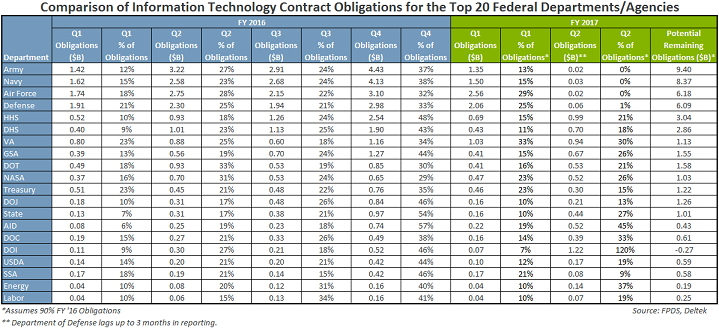Halfway Through FY 2017, Pt. 2 – How Much Are Agencies Spending on Information Technology?
Published: April 13, 2017
Even under a Continuing Resolution (CR) that covers more than half of the fiscal year, the largest agencies are on track to spend more year-over-year.
With the new Trump Administration focusing largely on priorities other than Information Technology (IT) and with weeks remaining before we expect to see a detailed FY 2018 federal budget, many in the contracting world are looking for clues to what agencies have been up to and have in mind for the future. Further, with the current CR expiring near the end of April – requiring Congress to pass additional funding bill(s) to cover operations for the remainder of FY 2017 – it might be helpful to know how IT spending has proceeded under the current CR to date and what might be in store for the remainder of this fiscal year.
Last week, I looked at the total market of federal contract obligations at the mid-fiscal-year point. This week I’ll focus specifically on contracted IT spending using a similar approach – by looking at year-to-year comparisons for Q1 and Q2 of FY 2016 and FY 2017 and then seeing what the rest of FY 2017 might have in store if agencies spend 90% of what they spent in FY 2016, (i.e. taking a cautious, conservative approach.)
Quarterly IT Contract Obligation Levels Compared
For Information Technology spending in FY 2016, the twenty top-spending departments accounted for more than $75 billion, or 97%, of the total $77.4 billion in total federal IT contract obligations. That is up from the $69.8 billion of the total $72.1 billion that the top twenty reported for FY 2015.
Breaking it down a bit further, these twenty agencies accounted for $11.2 billion and $18.3 billion in FY 2016 Q1 and Q2 obligations respectively, (up from $10.9B billion and $15.3B billion for Q1 and Q2 of FY 2015.) For comparison, these twenty departments reported $17.7 billion and $29.4 billion in IT contract obligations for Q3 and Q4 respectively for FY 2016, (compared to $16.5 billion and $27.0 billion for the same quarters in FY 2015).
In FY 2017 to date, these top twenty departments have reported $12.5 billion and $8.1 billion for Q1 and Q2 respectively, which are higher amounts than at this same point in the fiscal year last April when they reported $11.0 billion and $6.4 billion for those quarters, (although much of this Q2 FY17 bump is due to a $900 million year-over-year increase at the Department of the Interior.) Still, most departments reported stronger spending in Q1 FY 2017 compared to Q1 FY 2016, especially the Air Force, the Defense Agencies, and the VA – and this under a CR, which usually means the expectation of flat budgets. The DoD components lag in their contract data reporting by up to 90 days so Q2 is significantly understated. (See table below.)

Prospects for the Rest of FY 2017
Looking forward to the remainder of FY 2017, if these top agencies spend 90% of what they did in all of FY 2016 they will have more than $47 billion left to obligate in the remaining two quarters of this fiscal year. That is $1 billion more than I estimated for Q3 and Q4 of FY 2016 when I conducted a similar analysis.
One major variable in all this affecting the rest of FY 2017 is what Congress will do with many of the Trump Administration’s priorities and spending requests in the FY 2017 Budget Amendment, especially the additional $30 billion the president has requested to rebuild military readiness. Granted, if Congress appropriates the funding, the vast majority of this will go to combat readiness and related operations, but some could have IT implications. The $3 billion DHS FY 2017 Budget Amendment has more clear implications for IT spending, with millions of dollars identified for technology investments supporting increased border security. So far, though, these requests have been met with skepticism on Capitol Hill.